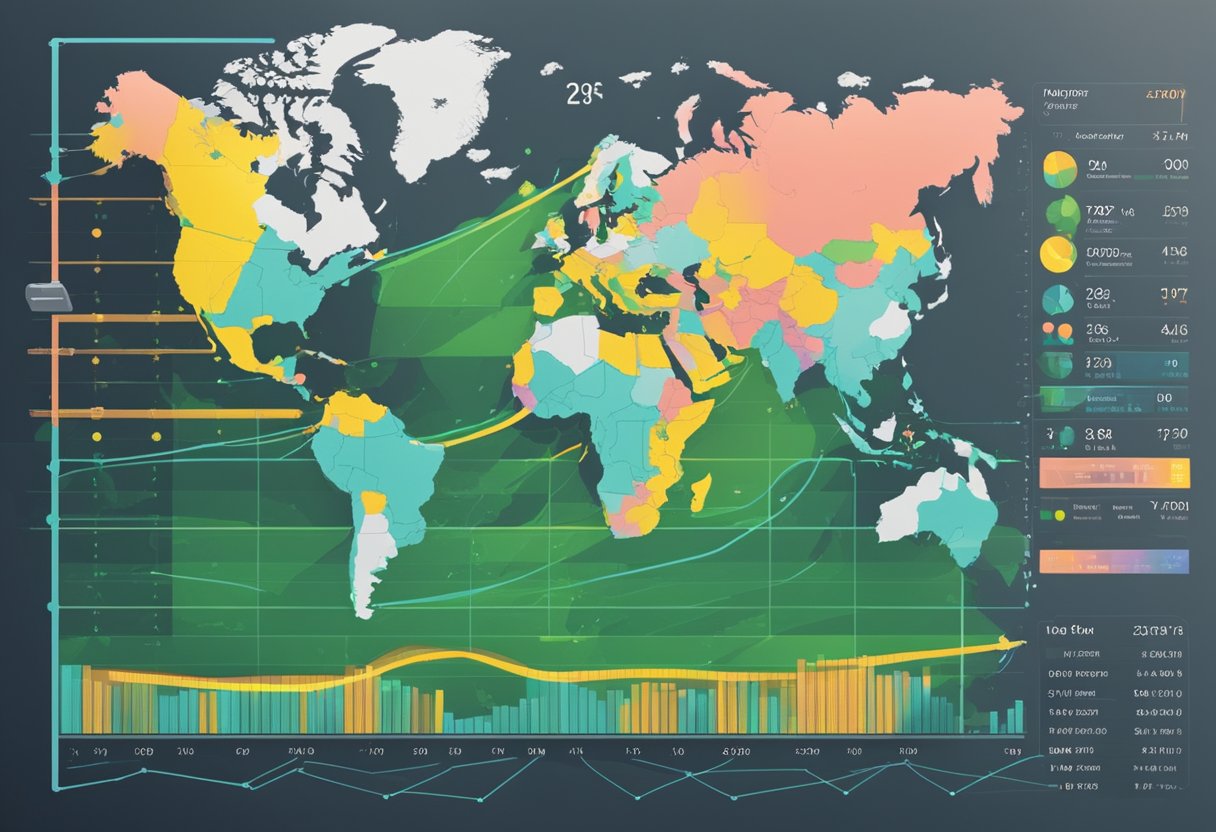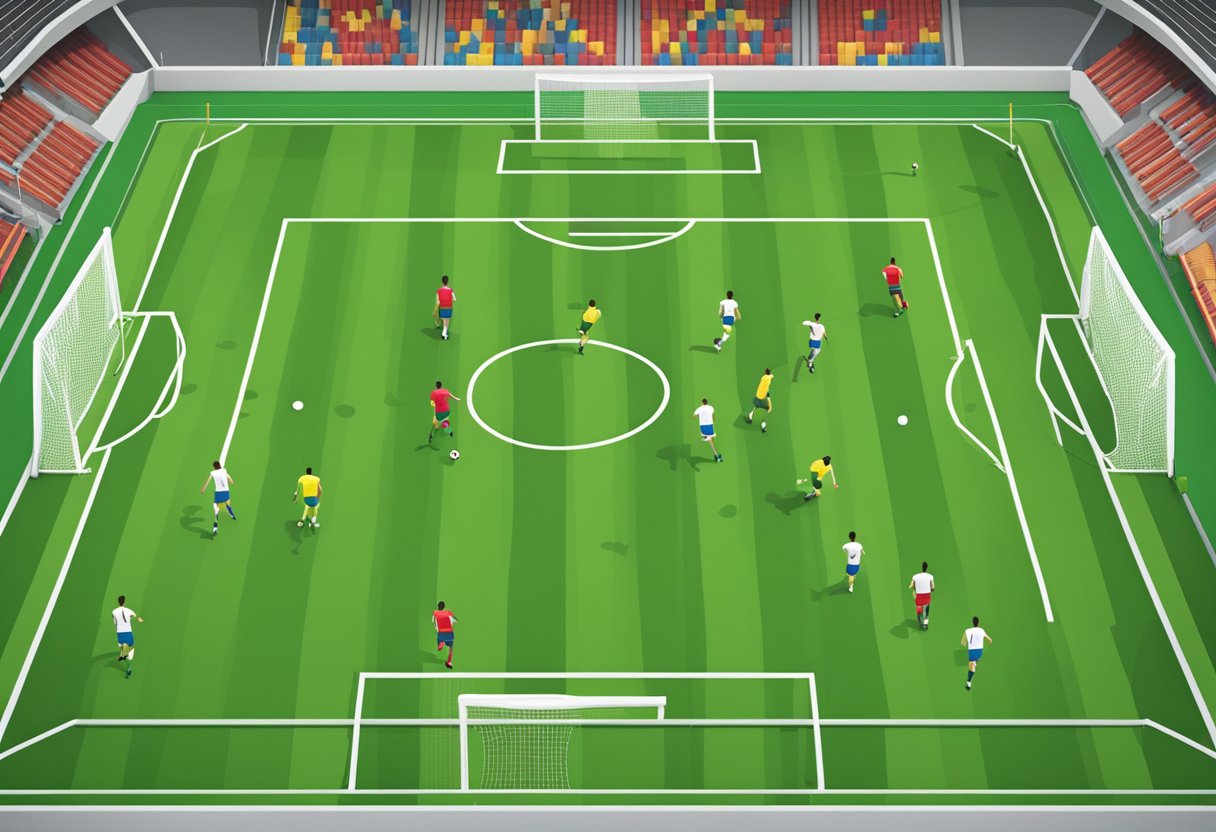Interpreting Tracking Data in Soccer: A Comprehensive Guide
Interpreting tracking data in soccer is an essential part of modern soccer analytics. Tracking data provides detailed information on players’ movements, positioning, and interactions with the ball, which can be used to improve player performance, develop tactical insights, and prevent injuries. However, interpreting tracking data can be a daunting task, requiring an understanding of data processing techniques, performance analysis, and data visualization and reporting.

To interpret tracking data in soccer, it is essential to have a fundamental understanding of the data itself. Tracking data is generated by sensors on players’ uniforms or by cameras placed around the field, which capture the players’ movements and interactions with the ball. The data is then processed to extract meaningful information, such as player speed, distance covered, and the number of passes made. This information can be used to analyze player performance, develop tactical insights, and prevent injuries.
Interpreting tracking data in soccer requires a combination of technical expertise and soccer knowledge. It is essential to understand the data processing techniques used to generate tracking data, as well as the performance metrics used to analyze player performance. Additionally, data visualization and reporting are critical to present the data in a clear and concise manner that can be understood by coaches, players, and analysts.
Key Takeaways
- Interpreting tracking data in soccer requires a fundamental understanding of the data itself, including the data processing techniques used to generate the data.
- A combination of technical expertise and soccer knowledge is essential for interpreting tracking data in soccer.
- Data visualization and reporting are critical to presenting tracking data in a clear and concise manner that can be understood by coaches, players, and analysts.
Fundamentals of Soccer Tracking Data
Data Collection Methods
Soccer tracking data is collected using various methods, including optical and non-optical systems. Optical systems use cameras to track player positions, while non-optical systems use sensors embedded in the players’ clothing or equipment. Optical systems are more accurate than non-optical systems, but they are also more expensive and require more setup time.
In recent years, there has been a significant increase in the use of optical systems for data collection. The most commonly used optical systems include GPS, radar, and computer vision. GPS systems are used to track the movements of players on the field, while radar systems are used to track the ball’s movements. Computer vision systems use cameras to track player positions and movements.
Types of Tracking Data
There are two types of tracking data in soccer: event data and positional data. Event data captures discrete events that occur during a game, such as passes, tackles, and shots. Positional data captures the continuous movement of players on the field.
Positional data is collected using optical systems, while event data is collected manually by human observers. Positional data is more comprehensive than event data, as it captures all player movements on the field. However, event data is easier to collect and analyze, as it is less complex and requires less processing.
In addition to event and positional data, other types of data that can be collected include physiological data, such as heart rate and body temperature, and biomechanical data, such as joint angles and muscle activation. These types of data can provide valuable insights into player performance and injury prevention.
Data Processing Techniques
Signal Processing
Signal processing is an essential technique used to analyze tracking data in soccer. It involves the use of filters to remove noise, smooth out data, and identify patterns. The most commonly used filter in signal processing is the Kalman filter. It is a recursive filter that estimates the state of the system based on noisy measurements. The Kalman filter is used to estimate the position, velocity, and acceleration of players on the field.
Data Cleaning
Data cleaning is the process of removing errors, inconsistencies, and outliers from tracking data. It is an important step in data processing as it ensures that the data is accurate and reliable. The most common errors in tracking data include missing data, incorrect player identification, and incorrect ball tracking. Data cleaning techniques include manual inspection, statistical analysis, and machine learning algorithms.
Data Interpolation
Data interpolation is the process of estimating missing data points in tracking data. It is necessary because tracking data is often incomplete due to occlusions, sensor failures, and other factors. Interpolation techniques include linear interpolation, cubic interpolation, and spline interpolation. The choice of interpolation technique depends on the nature of the data and the desired level of accuracy.
In summary, signal processing, data cleaning, and data interpolation are essential techniques used to analyze tracking data in soccer. These techniques ensure that the data is accurate, reliable, and complete. Using these techniques, analysts can extract meaningful insights from tracking data and improve the performance of soccer teams.
Performance Analysis
When analyzing soccer tracking data, there are several key areas that can be focused on to gain insights into player and team performance. These areas include player movement analysis, team formation and tactics, and physical performance metrics.
Player Movement Analysis
One of the most important aspects of soccer performance analysis is player movement analysis. By examining tracking data, we can gain insights into how players move around the field, how they interact with teammates and opponents, and how they contribute to the team’s overall performance.
To analyze player movement, we can use a variety of metrics, including distance covered, speed, acceleration, and deceleration. By examining these metrics, we can gain insights into which players are covering the most ground, which players are the fastest, and which players are the most agile.
Team Formation and Tactics
Another key area of soccer performance analysis is team formation and tactics. By examining tracking data, we can gain insights into how teams are setting up on the field, how they are moving the ball, and how they are creating scoring opportunities.
To analyze team formation and tactics, we can use a variety of metrics, including formation shape, passing patterns, and shot location. By examining these metrics, we can gain insights into which formations are most effective, which passing patterns are most successful, and which areas of the field are most likely to result in scoring opportunities.
Physical Performance Metrics
Finally, physical performance metrics are also an important area of soccer performance analysis. By examining tracking data, we can gain insights into how players are performing physically, including their endurance, strength, and agility.
To analyze physical performance, we can use a variety of metrics, including distance covered, speed, acceleration, and deceleration. By examining these metrics, we can gain insights into which players are the most physically fit, which players are the strongest, and which players are the most agile.
Overall, performance analysis is a critical aspect of soccer tracking data interpretation. By focusing on player movement analysis, team formation and tactics, and physical performance metrics, we can gain valuable insights into player and team performance that can be used to improve training, tactics, and overall performance on the field.
Tactical Insights
As a coach or analyst, interpreting tracking data in soccer can provide valuable insights into player performance, team tactics, and opposition analysis. Here are some ways to gain tactical insights from tracking data.
Opposition Analysis
One of the main benefits of tracking data is the ability to analyze the opposition’s tactics and weaknesses. By analyzing their movement patterns, we can identify their strengths and weaknesses in different areas of the pitch. This helps us to develop a game plan that exploits their weaknesses and neutralizes their strengths.
For example, by analyzing their pressing patterns, we can identify areas of the pitch where they are vulnerable to counter-attacks. We can also identify their preferred passing lanes and the players they rely on to create chances. Armed with this information, we can set up our team to disrupt their passing lanes and limit the influence of their key players.
Game Strategy Development
Tracking data can also be used to develop game strategies that maximize our team’s strengths. By analyzing our own players’ movement patterns, we can identify areas of the pitch where they are most effective. We can also identify the players who are most involved in our attacking play and the types of passes and movements that lead to the most chances.
For example, if we have a striker who is particularly effective in the penalty area, we can use tracking data to identify the types of crosses and through balls that lead to their chances. We can also analyze the movement patterns of our midfielders and wingers to identify the best areas to play the ball into the striker.
In conclusion, interpreting tracking data in soccer can provide valuable insights into opposition analysis and game strategy development. By using this data to identify strengths and weaknesses, we can develop game plans that maximize our chances of success.
Player Health and Injury Prevention
As a soccer coach, I know the importance of keeping players healthy and injury-free. Interpreting tracking data can help us manage player workload and assess injury risk, leading to better injury prevention strategies.
Workload Management
Tracking data can provide valuable insights into player workload. By monitoring metrics such as distance covered, sprint distance, and high-speed running, we can ensure that players are not overworked and at risk of injury.
One way to manage workload is to use GPS tracking technology to monitor training sessions and matches. This data can be used to adjust training schedules and rest periods to ensure players are not overworked.
Another way to manage workload is to use a rotation system. By rotating players in and out of the starting lineup, we can ensure that players have adequate rest and recovery time.
Injury Risk Assessment
Interpreting tracking data can also help us assess injury risk. By analyzing metrics such as acceleration, deceleration, and change of direction, we can identify players who are at risk of injury and adjust their training accordingly.
In addition, tracking data can help us identify specific areas of the body that are at risk of injury. For example, if we notice that a player is consistently experiencing muscle fatigue in their hamstrings, we can adjust their training to focus on strengthening those muscles and reducing the risk of injury.
Overall, interpreting tracking data can be a powerful tool for managing player workload and assessing injury risk. By using this data to inform our training and injury prevention strategies, we can keep our players healthy and on the field.
Data Visualization and Reporting
As a soccer analyst, it is essential to be able to convey insights derived from tracking data in a clear and concise manner. Data visualization tools such as dashboards and reports can help achieve this goal. In this section, I will discuss the benefits of using these tools and provide some tips on how to create effective dashboards and reports.
Creating Dashboards
Dashboards are an excellent way to visualize tracking data in real-time. They provide a snapshot of the game and allow analysts to identify trends and patterns quickly. When creating a dashboard, it is essential to keep the following in mind:
Keep it Simple: Dashboards should be easy to read and understand. Avoid cluttering the dashboard with too much information, as this can be overwhelming.
Choose the Right Metrics: Select metrics that are relevant to the game and the team’s strategy. For example, if the team’s strategy is possession-based, metrics such as passes completed and pass accuracy may be more relevant.
Use Visualizations: Use charts and graphs to convey information quickly. Visualizations such as heat maps and scatter plots can help identify patterns in the data.
Generating Reports
Reports are another way to communicate insights derived from tracking data. Reports are typically more detailed than dashboards and provide a more in-depth analysis of the game. When creating a report, it is essential to keep the following in mind:
Focus on the Key Takeaways: Reports should focus on the key takeaways from the game. Avoid including irrelevant information that can distract from the main points.
Provide Context: Provide context to the data by comparing it to previous games or the team’s overall performance. This can help analysts identify areas of improvement.
Use Visuals and Tables: Use visuals and tables to make the report more engaging and easier to read. Tables can be used to summarize data, while visuals can help identify trends and patterns.
In summary, data visualization tools such as dashboards and reports can help soccer analysts communicate insights derived from tracking data in a clear and concise manner. When creating these tools, it is essential to keep the audience in mind and focus on the key takeaways. By following these tips, analysts can create effective dashboards and reports that provide valuable insights to coaches and players.
Technology in Soccer Analytics
As soccer teams strive to gain a competitive edge, technology has become increasingly important in soccer analytics. Wearable technology and video analysis software have become essential tools for teams and coaches to interpret tracking data and gain insights into player performance.
Wearable Technology
Wearable technology, such as GPS trackers and accelerometers, has revolutionized soccer analytics by providing coaches and teams with real-time data on player performance. These devices can track a wide range of metrics, including distance covered, speed, acceleration, and deceleration. By analyzing this data, coaches can gain insights into player fitness and fatigue levels, as well as identify areas for improvement in player performance.
In addition to GPS trackers and accelerometers, wearable technology has also introduced new devices such as Playermaker, which provides physical data and metrics evaluating technical skills. These sensors are gaining a foothold in the scouting process, even if there’s a requisite learning curve to make sense of this new information.
Video Analysis Software
Video analysis software has become an essential tool for soccer teams and coaches to interpret tracking data and gain insights into player performance. This software allows coaches to analyze game footage and provide feedback to players on their performance.
By using video analysis software, coaches can identify patterns and trends in player performance, such as positioning on the field, passing accuracy, and decision-making. This information can be used to develop targeted training programs and improve player performance on the field.
Overall, technology has become an essential tool for soccer teams and coaches to interpret tracking data and gain insights into player performance. By using wearable technology and video analysis software, coaches can gain a competitive edge by identifying areas for improvement in player performance and developing targeted training programs to improve overall team performance.
Ethical Considerations and Data Privacy
As with any data-driven technology, the use of tracking data in soccer raises ethical considerations and data privacy concerns. It is important to ensure that the data is collected and used in an ethical and responsible manner, with the privacy of players and other individuals involved in the game being respected.
One of the main ethical considerations in the use of tracking data in soccer is the potential for misuse of the data. For example, the data could be used to unfairly advantage one team over another, or to target individual players for criticism or abuse. To prevent this, it is important to establish clear guidelines for the collection and use of tracking data, and to ensure that those guidelines are followed by all parties involved.
Another important consideration is data privacy. The tracking data collected during soccer matches can provide detailed information about the movements and actions of individual players, which could be used to identify them and track their movements both on and off the field. To protect the privacy of players, it is important to ensure that the data is collected and stored securely, and that access to the data is restricted to authorized personnel only.
To address these concerns, many soccer organizations have established ethical guidelines and data privacy policies for the use of tracking data in the sport. These policies typically include provisions for informed consent, data security, and data sharing, and are designed to ensure that the data is collected and used in a responsible and ethical manner.
Overall, the use of tracking data in soccer has the potential to provide valuable insights into player performance and team strategy, but it is important to approach this technology with caution and to ensure that it is used in an ethical and responsible manner. By establishing clear guidelines for the collection and use of tracking data, and by prioritizing data privacy and security, we can ensure that this technology is used to enhance the sport of soccer in a positive and responsible way.
Frequently Asked Questions

What technologies are used for tracking player movements in soccer?
Soccer teams use a variety of technologies for tracking player movements, including GPS devices, accelerometers, and gyroscopes. These technologies are typically embedded in wearable devices that players wear during matches and training sessions. The data collected from these devices can be used to analyze a player’s performance in real-time, including their speed, distance covered, and acceleration.
How can tracking data improve a soccer team’s performance?
Tracking data can provide valuable insights into a team’s performance. By analyzing the data, coaches and analysts can identify areas of weakness and develop strategies to improve performance. For example, tracking data can be used to identify players who are not covering enough ground during a match or who are not making enough tackles. This information can then be used to develop training programs that target these areas and improve the performance of the team as a whole.
What are the key statistics to focus on when analyzing a soccer match?
When analyzing a soccer match, there are several key statistics to focus on. These include possession, shots on target, passes completed, and tackles made. By analyzing these statistics, coaches and analysts can identify areas where the team is performing well and areas where improvement is needed. For example, if a team is struggling to maintain possession of the ball, coaches can develop training programs that focus on ball control and passing accuracy.
How do teams utilize GPS data to enhance player conditioning and strategy?
GPS data can be used to monitor a player’s physical condition and identify areas where improvement is needed. For example, if a player is not covering enough ground during a match, coaches can develop training programs that focus on improving their endurance and speed. Additionally, GPS data can be used to develop strategies that take advantage of a player’s strengths. For example, if a player is particularly fast, coaches can develop strategies that utilize their speed to create scoring opportunities.
What methods are used to ensure the accuracy of soccer tracking data?
To ensure the accuracy of soccer tracking data, teams use a variety of methods, including calibration, validation, and synchronization. Calibration involves ensuring that the tracking devices are properly calibrated and that the data collected is accurate. Validation involves comparing the tracking data to other sources of data, such as video footage, to ensure that it is accurate. Synchronization involves ensuring that all of the tracking devices are synchronized and that the data is collected at the same time.
How has the integration of data analysis software transformed soccer coaching?
The integration of data analysis software has transformed soccer coaching by providing coaches and analysts with access to a wealth of information about a team’s performance. By analyzing this data, coaches can identify areas of weakness and develop strategies to improve performance. Additionally, data analysis software can be used to develop customized training programs that target specific areas of weakness, which can lead to improved performance on the field.







